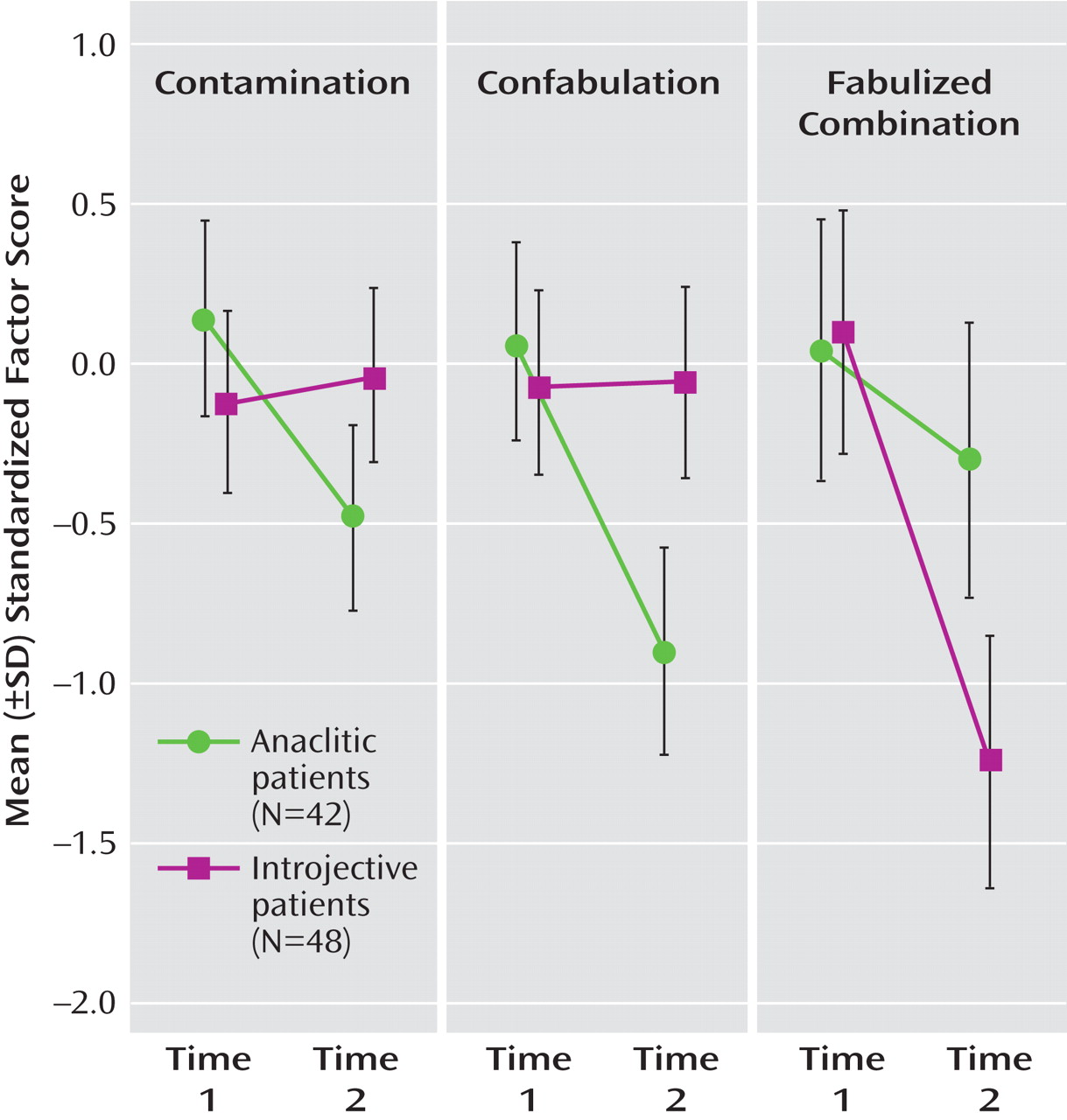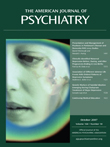An Improved Anaclitic Woman
At admission, “Ms. I,” a woman in her late teens, showed histrionic, obsessional, and paranoid qualities and a degree of interpersonal withdrawal. The working diagnosis at admission was of a long-standing depression in a histrionic character with serious borderline features. Ms. I’s parents had divorced when she was about 10 years old. At age 16, a year before her mother remarried, Ms. I gave birth to a child, placed it for adoption, and seemed to have suffered a postpartum depression.
At the case conference at time 2, her therapist described a long beginning phase of the therapy in which Ms. I behaved as if she were a small child, requiring the therapist to enact the role of protective parent. However, when the therapist refused to tolerate her coercive regression, Ms. I swung abruptly from being a clinging child to becoming a promiscuous woman, albeit without much feeling and without clear definition.
Particularly noteworthy in terms of thought disorder on the Rorschach protocol was the change of a response to card IV. At time 1, Ms. I reported perceiving an “angel fetus”: “This part in here (small white area in the center) sort of looks like a fetus. It’s got an umbilical cord, sort of misplaced a little, I think. A fetus with wings. (She laughs.) Like it’s an angel fetus.” (Angel fetus?) “The head and the little ass, and its feet were sort of coming down; they weren’t curled up. I guess it couldn’t be inside the womb in that position. It was a little high up, but it was attached to something in the center.” This elaborate response of a humanoid figure (a fetus) in a small white space embedded in the center of the blot was of inaccurate form and extensively elaborated with contamination tendency and confabulation (an “angel fetus”) and fabulized combination (a “fetus with wings”) thought disorder. At time 2 testing, this extensively described, securely ensconced thought-disordered “angel fetus with wings” becomes an unenclosed, largely undefined “person.” . . . “Some man. Who, I don’t know. He’s not pretty.”
At time 1, Ms. I’s autistically elaborated, symbiotically ensconced tiny human figure within a largely undefined other is passive and helpless as well as powerful and grandiose. By time 2, Ms. I used this same area of the blot to reveal an impoverished representation of an undesirable adult figure in an ambiguous, somewhat more benign surround. This shift in human representation corresponds well with Ms. I’s movement from a primitive merger transference to a relatively more distant, more separated involvement with her therapist, a movement partially disguised by her adolescent promiscuity.
This example of a decrease in more primitive forms of thought disorder (contamination tendency and confabulation responses, typical of anaclitic psychopathology) in elaborating an inaccurately perceived humanoid form (a “fetus”) to a non-thought-disordered, less defined, unelaborated, but more accurately perceived “person” is consistent with indications in the clinical material of a move toward a higher level of organization within the anaclitic configuration, a move from a more dependent borderline to a more integrated histrionic level of organization.
Ms. I left the hospital prematurely 12 months later, primarily because of financial considerations, but it was also several months after a very close friend had left. While it was felt that she had definitely improved, her functional capacity to maintain commitments was seen as limited, indicating a continued need for the sustained involvement of significant adults to help modulate her ongoing severe sense of shame and doubt. Since these conditions clearly indicated her need for further treatment, her prognosis was guarded, depending on the quality of the therapeutic environment she might be able to discover.
An Improved Introjective Woman
“Ms. K,” a woman in her mid-20s, had experienced a growing sense of futility, depression, and detachment. She was becoming seriously confused and was no longer able to function in the daily tasks of work and living. Her diagnosis at admission was of decompensation in a long-standing severe obsessive character disorder with depressive and masochistic features. Sad and angry-looking, she hid her femininity. Clearly depressed, she withdrew from others, at times appearing tense and flushed, as if she were in a rage. She described herself as having two parts: her controlled, ordinary self and “something else.” She feared she could become violent. At her most depressed, Ms. K described herself as being completely detached and without feelings. She revealed great sexual confusion and was very much frightened by the prospect of intimacy. When she allowed the expression of some hope, she said that she wanted to establish a more effective identity—to be in contact with herself, to be a woman and not an overgrown child.
Her treatment was described at her time 2 case conference as having proceeded well. Crucial elements were her male therapist’s flexibility, playfulness, and availability for gradual attachment and for an increasing number of partial identifications.
In terms of thought disorder on the Rorschach protocol, the change in her responses to card VIII was noteworthy. At time 1, she reported, “This thing up here is a genie.” (Genie?) “Partly because it’s a peculiar-looking thing coming up behind two curtains, as if it might come out of a bottle. An ethereal sort of thing. That much is behind the curtain” (fabulized combination). “The rest of it is some kind of curtain—except for his head and arms—that he’s hiding behind. I don’t know what he’s doing.” (Curtain?) “It doesn’t particularly, but it’s just something that the genie is coming out of.” (Out of?) “No, I mean he’s coming over the top of it. Kind of like the wizard in The Wizard of Oz . The wizard comes out from behind the curtain” (confabulation tendency). At time 2, she responded to the same card: “Upside-down it looks like a torso, opened, so it’s flat and these two things . . . are lungs, and some ribs in the middle, and that’s [at bottom] a pelvis, and this, the spine [as she runs her finger up the middle of the card], and that’s [blue] muscles in the back, and this part [orange] muscles in front, and these two [center pink] are breasts, and it hasn’t got a heart. That’s unfortunate.” (Where had she seen something like this?) “Perhaps in my science lab when I was in ninth grade. I can’t think of any place since then. I have in my mind a fancy anatomy textbook with plastic layers in it and all done in bright colors.” Among the evidence of change are the reduction of thought disorder and Ms. K’s greater control over the urgency of her associations. At time 1, she reacted to the greater stimulation of the color of the Rorschach card as helplessly as to an unfolding drama. At time 2, the stimulus impinges less on her, and she is in more control in her intellectualized response of a fancy anatomy textbook with plastic layers.
This change from less primitive forms of thought disorder (confabulation tendency and fabulized combination responses, typical of introjective psychopathology) in a mystical powerful quasi-human form (a “genie”) hidden behind two curtains to a more intellectualized non-thought-disordered response of a layered anatomy textbook is consistent with indications in the clinical material of a move toward a higher level of organization within the introjective configuration, a move from a more grandiose paranoid to a more integrated obsessive-compulsive level of organization.
When Ms. K left the hospital some 4 months later, she was seen as consolidating her gains and advancing significantly toward a more mature feminine character. She evinced a steady pulling together of resources, increasing her explorations into both the world of people and the world of work. At the time of the mutually agreed-on discharge, she thought she would like to plan her future without seeking further psychotherapy.


